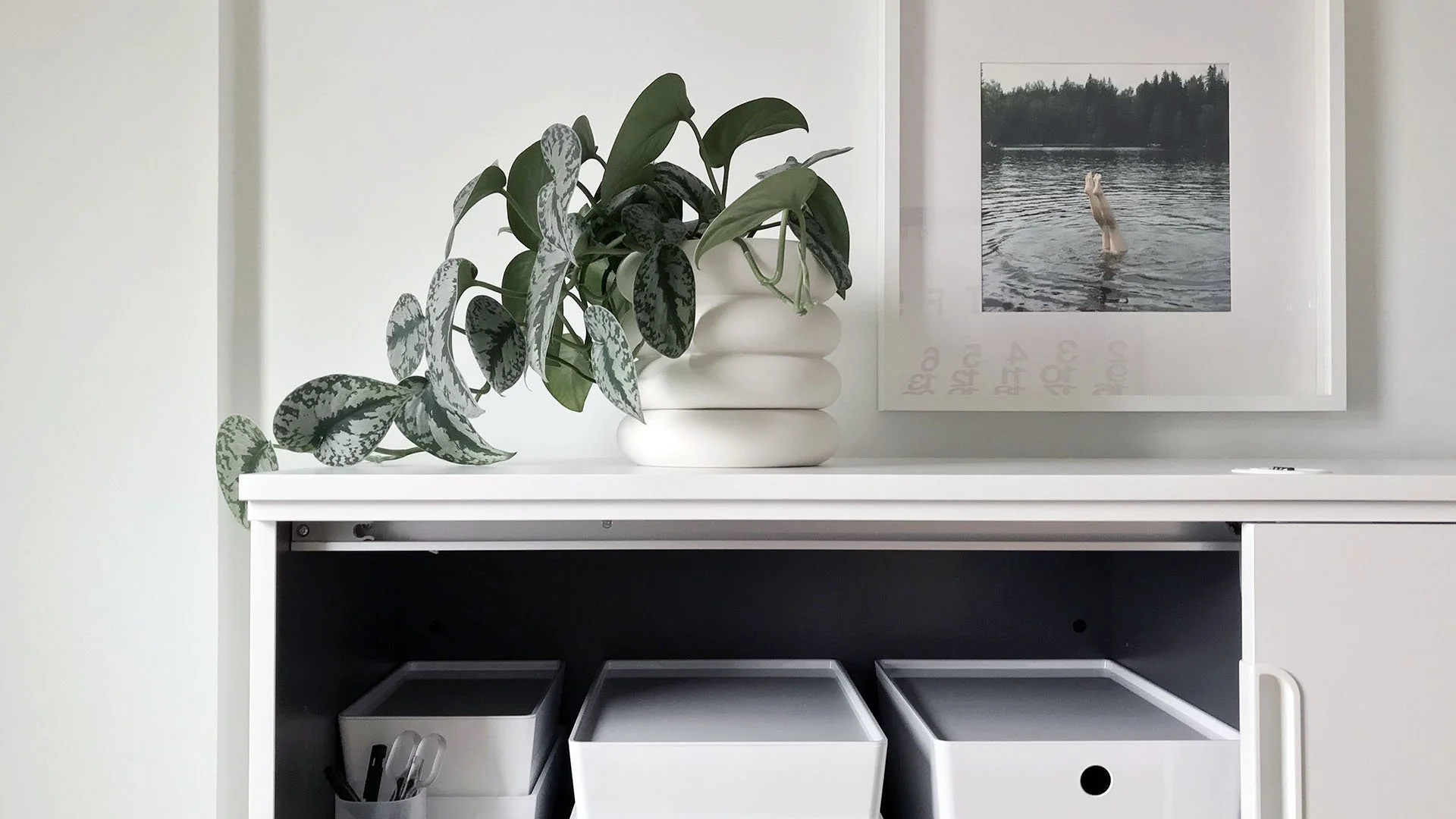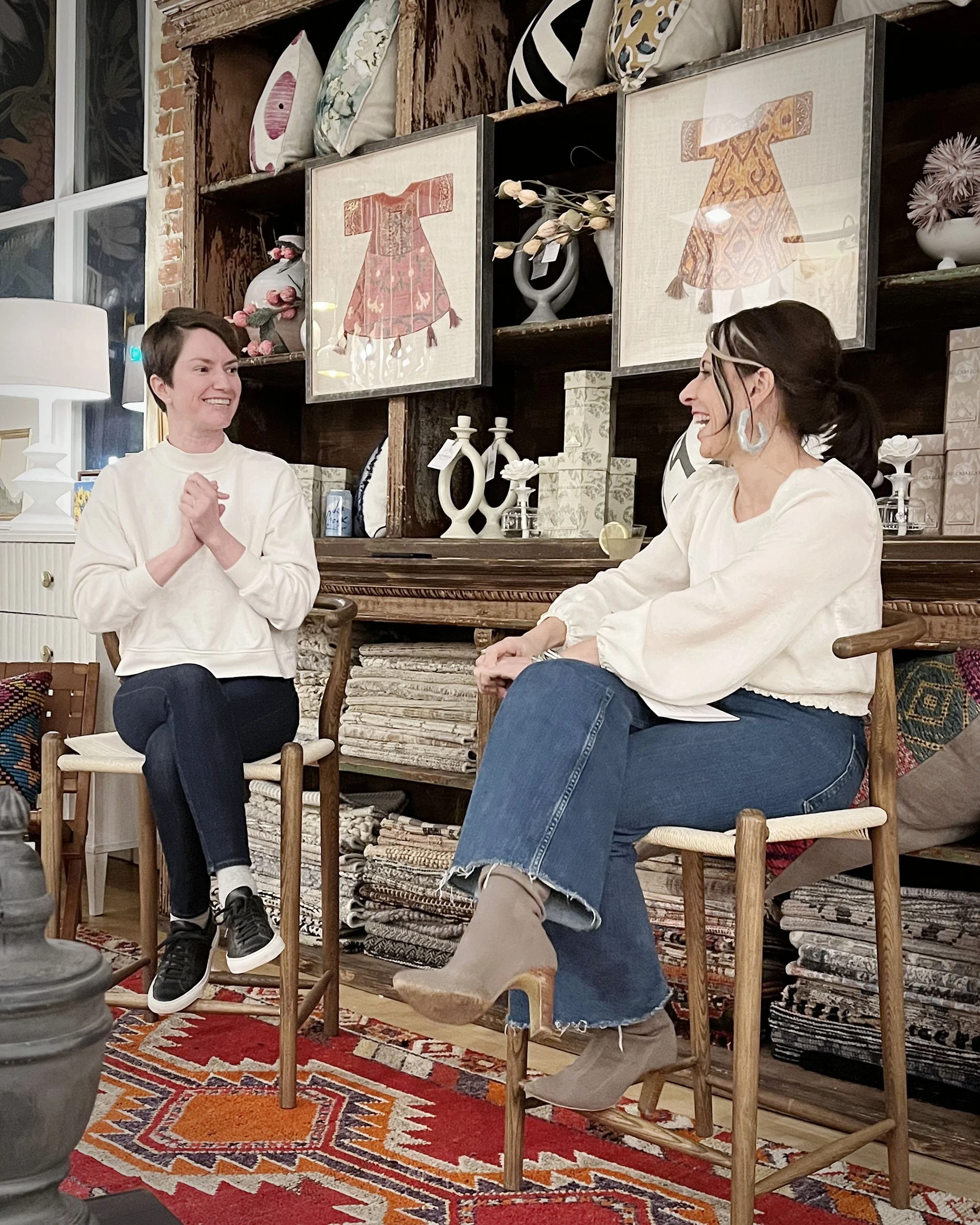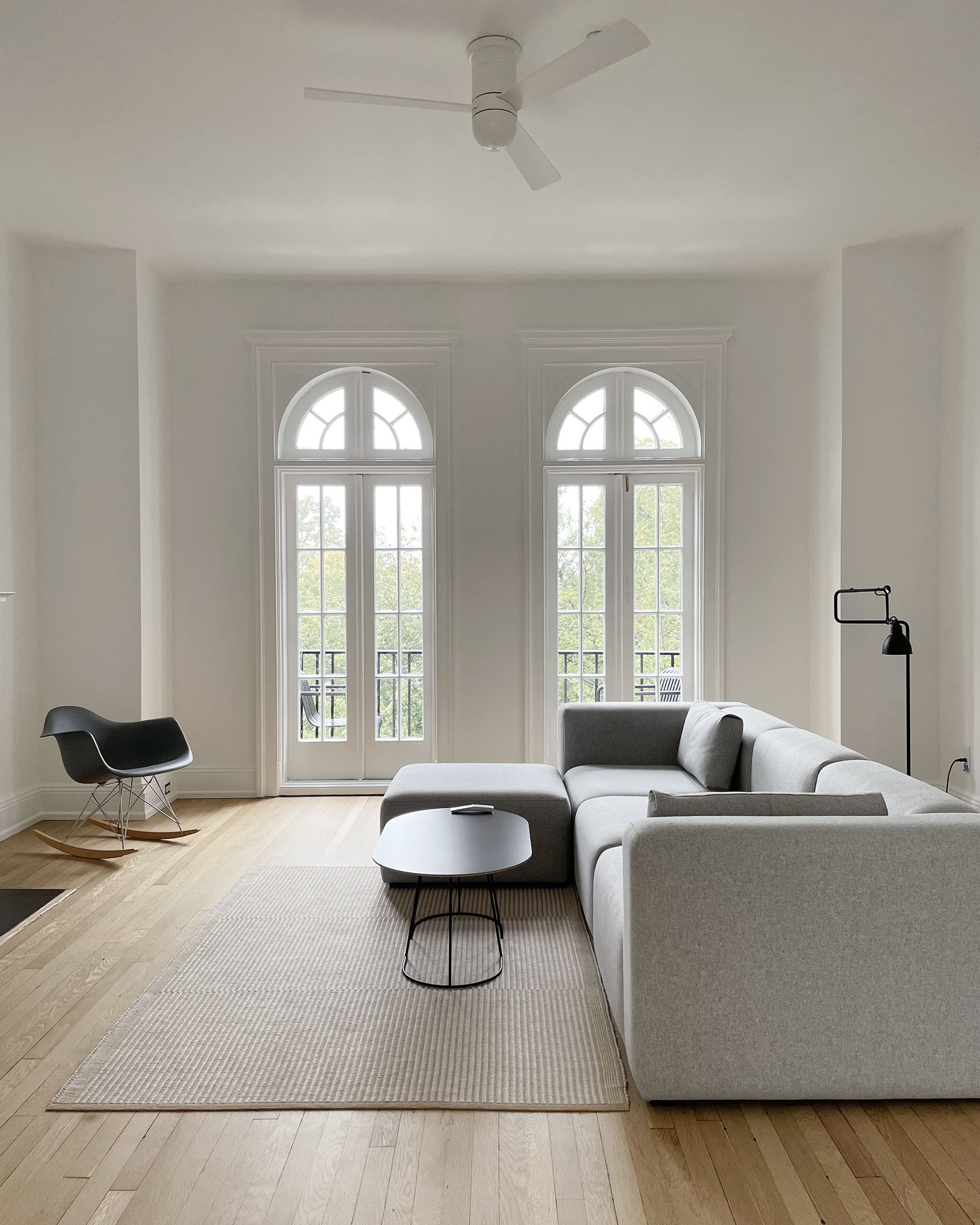A Conversation About Organizing and Interior Design
Last month Stevie McFadden, owner of Flourish Spaces and one of Minima’s preferred home service professionals, hosted a live event at her interior design studio where she and I discussed ideas around organizing, design, minimalism, and living an intentional life. We even unpacked the question, “Can a design maximalist embrace minimalist principles?”
The event had a great turn out and so many good questions during the Q&A portion. I’ve summarized our conversation points below and linked to the full hour long video at the end. You can watch the full hour-long video of our conversation below. We opened it up to audience Q&A at minute 24:30 if you want to hear more!
Stevie: For those who might not be familiar with Minima, could you explain what you do and how you got started doing this very interesting, niche thing?
Kristen: I wrote a Minima Journal post, “My Minimalism Journey” with all the details. The abbreviated version is, I was working as an Architect in Richmond and was laid off during the housing market crash. Shortly after, a friend told me about NAPO (National Association of Productivity and Organizing Experts) and I went to a local chapter meeting. I was hired by another organizer and trained under her for a year or so before starting Minima. For several years after losing my architecture job, I was under or unemployed. In order to stay financially afloat, I chose to sell much of what I owned and drastically cut back on spending. I didn’t realize what I was doing formed part of “minimalism”—living a meaningful life with less—until later on. It was incredibly empowering and my life had a new sense of freedom and peace. As my circumstances have changed, I’ve carried the values of minimalism with me. While Minima never forces or expects our clients to become minimalists, our company is founded on the principles of minimalism. It naturally breathes through in our work.
Kristen and Stevie during their conversation
Stevie: People have all kinds of perceptions. I imagine you have a lot of barriers you have to overcome when you start working with clients. For example, a client might be ready but his/her partner or children might not. How do you show people it’s not about “doing without” or having an austere philosophy?
Kristen: We talk a lot about defining the vision when we first meet with clients. Why did you call us and what is bringing you discontent? We do get into pragmatic solutions, but we are primarily focused on creating a home that supports the client’s vision and talking about things to subtract or reimagine. Most people’s instinct is to add to solve a problem. I’m reading Subtract: The Untapped Science of Less by Leidy Klotz which talks about human’s instinct to add to problem solve, and the often missed opportunities in subtraction. When people talk about other people in their home not being onboard, we recommend starting with what you have control over and set an example. Usually other people in the household will see the results and come around.
Stevie: How would you apply your philosophy to someone like me? I would describe myself as a maximalist. I love things, but I know great design is about editing and knowing when to take things away. Can our two ways of being co-exist?
Kristen: They can! I would describe clutter as anything that gets in the way. If your things add value to your life and don’t get in the way, they aren’t clutter. Minima’s philosophy isn’t about how many things you have, but about your things being intentionally selected and supporting the vision you have for your life. Minima’s mission statement is Make what is necessary beautiful®—eliminating the excess and working with what remains to create something beautiful and meaningful.
Stevie: How do you get people to loosen their grip on the excess things in their life?
Kristen: I share some in depth tips in the Minima Journal post, “Beyond Sparking Joy: How to Decide What to Keep or Discard”. When we are physically in a client’s home sorting, our technique is to gather all items from a zone and review them together as a complete set—clothing, books, whatever the focus area is for the session. Seeing everything out and together often has a lot of shock value for our clients because they didn’t realize they had so much. This helps them pare down and differentiate between the items adding value to their lives versus the ones they never use or didn’t even know they owned. We are hardwired to be prepared for every possible scenario, to keep things “just in case”, but that gets in the way of living life in the present moment. I have a saying, “Don’t let your past or possible future drown out the now.” There’s nothing wrong with keepsake (items from your past), but it’s important to have boundaries. If you’re keeping something based on a future-based fear that you might need it some day, but you can’t think of a specific scenario when you’d use it, let it go.
Stevie: Sometimes a large value in both our services is being a fresh set of eyes. You move a dresser into a new space and it becomes something totally new. Can you speak to that?
Kristen: Definitely. I have another saying, “Any home can be a dream home through minimizing and organizing.” Even the apartments I had right out of college were made into dream homes for me at that stage in my life. I would always deep clean and spend some time maximizing space and natural light, as well as organization. When you edit to the things that are necessary or highly meaningful to you, a natural arrangement of space organically happens. It feels warm and honest, not contrived. Some of the best design moments in my homes have been happy accidents. In other words, I allowed myself to play a little and see what would happened. When I feel stuck on the design for a space, sometimes I will go big and make dramatic changes in furniture placement/etc. just to explore the option. Usually I will put everything back, but making the big change showed me the small tweak that makes everything work.
Kristen’s origami wall sculpture
Stevie: We always tell clients at the beginning of a project, “Something is going to go wrong on this project. We don’t know what it’s going to be, but something will go wrong.” There’s also always a happy accident in every design project. To your point about being resourceful, I have always been a big believer that limitations are wonderful to breed creativity.
Kristen: I love limitations. When I was in one of my first apartments after college I had no money to spend on art, but I wanted to create something large scale for my dining room. I asked myself, “What can I do with my limited resources?” I’ve loved origami since I was a child, so I decided to fold a series of paper cranes. I found a picture of a flock of birds and transposed it to scale using Photoshop. I measured each point on the wall like a mathematician/architect (something I love to do when hanging things). It turned out really well and cost almost nothing. You can see the installation here. If I had all the options in the world, I would have felt overwhelmed.
Stevie: We refer a lot of clients back and forth. Do you recommend hiring an organizer before or after a renovation?
Kristen: The best time is before. Often through organizing and minimizing first, we can hone in some specifics about a renovation that may have been unclear. For example, I was working with a client to organize her home while she was simultaneously working with an architect on a kitchen remodel. Her home was a Mid-Century Modern gem designed by a Japanese architect. She loved the kitchen as it was, but couldn’t figure out how to make it work for her modern day needs. Through our work together, we were able to declutter and reorganize in a way that made it clear what small changes needed to be made to the existing layout without having to change up the entire floor plan.
Stevie: I think that goes back to what you were saying before where people feel they need to add or move to a bigger home. In reality, there are smaller tweaks that can be made.
Kristen: Definitely. You said you have that moment of telling clients something will go wrong during a project. When we order organizing product for a client, we can’t possibly know exactly what will go in each bin. We are spatially minded, so we can estimate pretty accurately, but things always turn out a little differently than we think. I used to playfully tell my employees, “Make it work!” like Tim Gun from Project Runway. There is always more than one way to solve the problem.
Stevie: That’s what good design is, it’s about solving a problem. I love your mission statement, Make what is necessary beautiful®. It starts with what you need. I think too often we start with putting the lipstick on it and trying to make it look pretty, but it’s not really addressing what’s going on. Where is a good place for someone to start their simplification journey?
Kristen: Start by defining your why, because that’s what will motivate you. It could be, “I want to spend more time with my family”, “I want to reach financial freedom”, “I want to eat better, feel better, get better sleep”. Whatever it is, you can go back to it when you get stuck. Also, start easy—don’t start with your grandmother’s keepsake or paperwork. Your clothing or kitchen are great places to start because most of us use these spaces every day so it’s easier to determine what adds value versus what you can let go.
Stevie: I love these bigger goals behind simplifying. Can you talk more about how designing an organized kitchen could help you eat better, for example?
Kristen: The kitchen is a great example because it’s directly related to the food we’re consuming. When we have a lot of clutter, it’s a distraction. It’s harder to make good choices or be intentional and present. When we clear the clutter, there’s no distraction—we are forced to face whatever our life is and the feelings we have about it. When I think back to my unemployment days, I had no distractions and had to take a hard look at my life: would I leave architecture, start a new career, leave Richmond? Clutter is like constant text messages on your phone disrupting you throughout the day. So if your kitchen is organized, you’ll be able to find the food you need easily, enjoy cooking with less stress, maybe even try out new recipes. The same goes for clothing. If you simplify to only the things you love, that fit, that work together as a wardrobe, then getting dressed becomes easy rather than a frustration. My personal vision is freedom and peace, being able to focus on doing the things I love and maximizing time with family and work for Minima, getting good sleep. I feel like I’m on a vacation when I’m home (unless I’m in the middle of a renovation).
Stevie: Your home feels so peaceful, serene and beautiful. I jokingly said I wanted to burn my house down and start from scratch after seeing yours. I’m a maximalist and was shocked by my reaction to it. I think you’ve achieved that sense of peace and it’s apparent to visitors as well.
Kristen: Thank you! It’s funny, when people first meet me they say I come off as very calm. I’m naturally an anxious person. I’ve tried to design my life around staying calm. Pilates, good sleep, a supportive space.
Kristen’s current 1914 Fan home, which she and her husband moved to in September 2022



